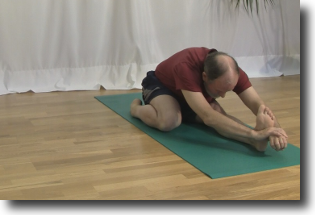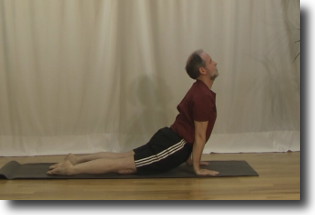Whenever Bob does Triang Mukha Eka Pada Paschimottanasana (pronounced tree-AWN-guh moo-KA-eh-ka-paw-duh , POSH-ee -MO-tun-ASH-anna) his ankles complain bitterly.
When Bob does Triang Mukha Eka Pada Paschimottanasana he places one shin on the floor with his foot next to his hip and his other leg is extended straight ahead. He needs a lot of flexibility in his ankle joint in order to get his shin and foot flat to the floor and avoid the pain.
Bob does not believe his yoga teacher when she says that a little dog can help him to be more comfortable in this pose.
What is the problem
Bob’s ankles hurt because he does not have enough flexibility to let them rest comfortably on the floor.
Bob needs to be able to put his foot and shin flat to the floor with his heel pointing up towards the sky. In this position for maximum comfort Bob’s ankle needs to be resting on the floor.
This is Bob’s problem, his ankle will not come to the floor and there is a lot of pressure on the muscles and tendons as he lowers his hips towards the floor beside his ankle.
Triang Mukha Eka Pada Paschimottanasana requires that Bob have a lot of flexibility right away in his ankle joint in order for him to be comfortable.
Bob needs to develop more flexibility in his ankle and a couple of dogs can do that for him.
How to develop flexibility in your ankle without the pain
Up Dog which in Sanskrit is Urdhva Mukha Savasana (pronounced OORD-vah MOO-kah shvoh-AHS-anna) will help Bob to develop the flexibility that he needs in his ankles without the pain that Triang Mukha Eka Pada Paschimottanasana is causing.
How to do Upward Facing Dog
You start by laying flat on the floor with your belly down, your hands under your shoulders and your fingers spread wide. Your elbows are by your side, your feet are close together and your toes are tucked in under your heels.
From here you start to inhale and lift your shoulders up towards the sky and straighten your arms.
As you lift your shoulders and torso up into the air, bring your hips forward and off of the floor as well. This forward movement of your hips will bring your shins forward and cause your ankles to come forward and down towards the floor.
You are completely in the pose when your arms are straight, your shoulders are over your finger tips and your hips and legs are off of the floor. The only parts of your body touching the floor are your hands and your feet.
Now hold here for several breaths with your gaze towards the horizon.
How is Upward Facing Dog going to help?
Triang Mukha Eka Pada Paschimottanasana requires the full range of motion in Bob’s ankle joint right away and that puts a lot of pressure and strain on his ankle joint.
Up Dog does not put any pressure on the ankle at all. Upward Facing Dog works within the range of motion that your ankle currently has. However you can use this pose to increase the flexibility of your ankle by doing a very simple thing.
How to increase your ankle flexibility
Once you have entered Up Dog with your shoulders above your finger tips and only your hands and feet on the mat you can start working on your ankle flexibility.
Lift your torso up between your shoulders and bring your hips forward towards your arms. This movement will require the ankle joint to straighten out some more.
Next bring awareness to your ankle joint and focus on bring the ankle joint down towards the floor. This movement will lengthen and straighten your ankle joint even more.
The good thing about this pose is that it works with your ankle joint the way it is. There is no requirement for your ankle joint to be fully flexible in order to do the pose comfortably Gradually over time doing Up Dog helps to increase the flexibility in your ankle.
Bob will know when he has fully developed the flexibility in his ankle joint when he can easily lift his toes off of the floor while he is in Up Dog.
Bob needs to watch out for the trap that a lot of people fall into when they are attempting to get their ankles to the floor.
Don’t roll your feet out to the side
Letting your feet roll out to the side with the heels going away from each other will let your ankles come flat to the floor right away. This rolling of the feet out to the side does nothing for developing the flexibility of your ankles. This is a very easy motion to do and most people are not aware that they are doing it until their yoga teachers point it out to them.
You need to avoid this tendency to let your feet roll out to the side as you move into Up Dog.
When you bring your awareness to your feet and ankles and work to bring your ankles down towards the floor, make sure that your heels continue to point up to the sky and not outwards toward the horizon.
Summary
Several months have gone by since Bob started doing Up Dogs with an added focus on his ankles. His ankles are now resting on the floor and he is able to lift his toes slightly off of the floor. Bob is sure that he is ready to try Triang Mukha Eka Pada Paschimottanasana again and without pain this time
Next Step
Talk to your yoga teacher about using Up Dog to help with your ankle flexibility. They will be able to help you to get maximum benefit from the pose and they will also make sure that you do not fall into the common trap of rolled out feet.
Additional Reading
While Up Dog is a fun and easy pose to do, you do need to protect yourself from injury. Read this article to find out more: How to avoid injuring yourself in Upward Facing Dog.
You can learn about protecting your wrists in Up Dog by reading How to protect your wrists in Upward Facing Dog, use the Redwood technique.
You can protect your lower back in Up Dog by following the simple technique described in How the Suspension Bridge Method protects your lower back in Upward Facing Dog.





